
Kveik is a collective term for a family of strains of brewing yeast that has been used in Norwegian farmhouse brewing for generations.

Kveik is a collective term for a family of strains of brewing yeast that has been used in Norwegian farmhouse brewing for generations.
In the past all Norwegian farmers brewed beer from their own grain. The yeast was kept by the farmers themselves between brews. If a farmer had a brew go sour, or found that the yeast in any way had gone bad or died, they were supplied with new, healthy yeast from a neighboring farm. As farming was modernized and beer became commercially available, most farmhouse brewing died out and the yeast cultures with it. Many places where the brewing tradition survived brewers started to use bread yeast from the local store instead of the old yeast from the farm. [1] The existence of kveik today is a result of a continuous tradition, sometimes only by a handful of traditional brewers in western Norway, that has kept the original kveik strains alive along with local traditions and techniques.
On the west coast of Norway, from Hardanger in the south to Sunnmøre in the north, there are still some yeast cultures that have survived and are in use to this day. Known cultures are listed in a publicly maintained registry, together with other farmhouse yeast cultures. [2]
These yeast cultures have often been handed down from father to son along with the knowledge of malting grain and brewing. All the strains that have been collected and analyzed in a laboratory have turned out to belong to the species Saccharomyces cerevisiae (common brewing yeast). They are also more closely related to each other genetically than to the yeast strains from other parts of the world. Thus, the surviving yeast on the west coast of Norway makes up a subcategory on the phylogenetic tree of brewing yeast, and it is yeasts belonging to this family which are referred to as kveik.
No kveik has as yet been found outside of western Norway. [3]
Genetic analysis shows that kveik belongs to the large category of brewing yeast called "Beer 1", which includes many of the known yeast strains from Germany, Belgium, Great Britain, and the USA. Kveik seems to be a hybrid of a progenitor from this known family with an unknown yeast, most likely a wild yeast. [4]
Although kveik is a domesticated brewer's yeast it differs from most modern brewer's yeast in several ways: [5]
Kveik is the most common dialect word for yeast in the parts of Norway where these strains originate. Many traditional brewers refer to their own yeast as 'kveik' whilst the commercially available yeast is called simply 'yeast'. The word 'kveik' in the meaning of 'yeast' stems from the old Norse word 'kvikk' (Eng: vigorous and fast) in the meaning of 'healthy, lively'. The English word 'quick' comes from the same root. [6]
In recent years kveik has spread from the traditional brewers on the west coast of Norway to modern home brewers and some commercial breweries in Norway, and even the rest of the world. Kveik is now sold commercially by laboratories in the USA, Canada, Ireland, Britain, and Poland. Commercial brews are being made and sold using the kveik yeast strains globally, and the interest for these particular yeast strains has increased immensely. [7] Beer festivals dedicated to beer brewed with kveik have been organized in the USA. [8]
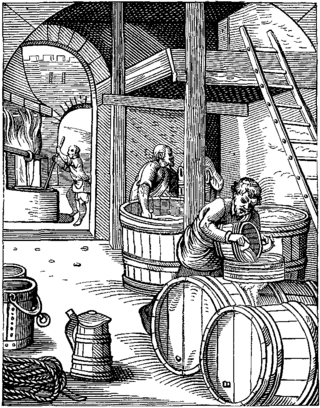
Brewing is the production of beer by steeping a starch source in water and fermenting the resulting sweet liquid with yeast. It may be done in a brewery by a commercial brewer, at home by a homebrewer, or communally. Brewing has taken place since around the 6th millennium BC, and archaeological evidence suggests that emerging civilizations, including ancient Egypt and Mesopotamia, brewed beer. Since the nineteenth century the brewing industry has been part of most western economies.

Yeasts are eukaryotic, single-celled microorganisms classified as members of the fungus kingdom. The first yeast originated hundreds of millions of years ago, and at least 1,500 species are currently recognized. They are estimated to constitute 1% of all described fungal species.

Baker's yeast is the common name for the strains of yeast commonly used in baking bread and other bakery products, serving as a leavening agent which causes the bread to rise by converting the fermentable sugars present in the dough into carbon dioxide and ethanol. Baker's yeast is of the species Saccharomyces cerevisiae, and is the same species as the kind commonly used in alcoholic fermentation, which is called brewer's yeast or the deactivated form nutritional yeast. Baker's yeast is also a single-cell microorganism found on and around the human body.

Saccharomyces cerevisiae is a species of yeast. The species has been instrumental in winemaking, baking, and brewing since ancient times. It is believed to have been originally isolated from the skin of grapes. It is one of the most intensively studied eukaryotic model organisms in molecular and cell biology, much like Escherichia coli as the model bacterium. It is the microorganism behind the most common type of fermentation. S. cerevisiae cells are round to ovoid, 5–10 μm in diameter. It reproduces by budding.

Lambic is a type of beer brewed in the Pajottenland region of Belgium southwest of Brussels and in Brussels itself since the 13th century. Types of lambic beers include gueuze, kriek lambic, and framboise. Lambic differs from most other beers in that it is fermented through exposure to wild yeasts and bacteria native to the Zenne valley, as opposed to exposure to carefully cultivated strains of brewer's yeast. This process gives the beer its distinctive flavour: dry, vinous, and cidery, often with a tart aftertaste.

Saccharomyces is a genus of fungi that includes many species of yeasts. Saccharomyces is from Greek σάκχαρον (sugar) and μύκης (fungus) and means sugar fungus. Many members of this genus are considered very important in food production. It is known as the brewer's yeast or baker's yeast. They are unicellular and saprotrophic fungi. One example is Saccharomyces cerevisiae, which is used in making bread, wine, and beer, and for human and animal health. Other members of this genus include the wild yeast Saccharomyces paradoxus that is the closest relative to S. cerevisiae, Saccharomyces bayanus, used in making wine, and Saccharomyces cerevisiaevar. boulardii, used in medicine.
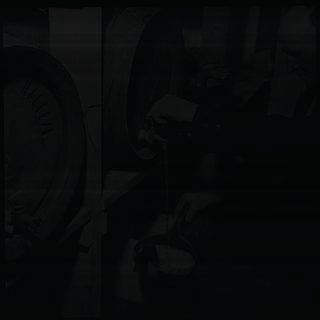
Beer in Norway has a long history, stretching back more than a millennium. Until some 200 years ago, most farms where it was possible to grow grain south of the Arctic Circle, brewed their own beer. From the early 20th century brewing was industrialized and home brewing was restricted. Significant consolidation in the brewing sector reduced the number of major breweries to just a handful. With the exception of the farmhouse ales, most beer styles brewed in Norway trace their ancestry to central Europe.
Saccharomyces pastorianus is a yeast used industrially for the production of lager beer, and was named in honour of Louis Pasteur by the German Max Reess in 1870. This yeast's complicated genome appears to be the result of hybridisation between two pure species in the Saccharomyces species complex, a factor that led to difficulty in establishing a proper taxonomy of the species.
Saccharomyces bayanus is a yeast of the genus Saccharomyces, and is used in winemaking and cider fermentation, and to make distilled beverages. Saccharomyces bayanus, like Saccharomyces pastorianus, is now accepted to be the result of multiple hybridisation events between three pure species, Saccharomyces uvarum, Saccharomyces cerevisiae and Saccharomyces eubayanus. Notably, most commercial yeast cultures sold as pure S. bayanus for wine making, e.g. Lalvin EC-1118 strain, have been found to contain S. cerevisiae cultures instead
Blaand, or bland, is a fermented milk product made from whey. It is acidic and has very low alcohol content.

Farmhouse ale is an ancient European tradition where farmers brewed beer for consumption on the farm from their own grain. Most farmers would brew for Christmas and/or the late summer work, but in areas where they had enough grain farmers would use beer as the everyday drink.

Lager is beer which has been brewed and conditioned at low temperature. Lagers can be pale, amber, or dark. Pale lager is the most widely consumed and commercially available style of beer. The term "lager" comes from the German for "storage", as the beer was stored before drinking, traditionally in the same cool caves in which it was fermented.

American wild ale is a sour beer brewed in the United States using yeast or bacteria in addition to Saccharomyces cerevisiae for fermentation. Such beers are similar to Belgian Lambic and Oud bruin, and typically fermented using a strain of brettanomyces, resulting in a "funky" flavor.
Saccharomyces eubayanus, a cryotolerant type of yeast, is most likely the parent of the lager brewing yeast, Saccharomyces pastorianus.

The role of yeast in winemaking is the most important element that distinguishes wine from fruit juice. In the absence of oxygen, yeast converts the sugars of the fruit into alcohol and carbon dioxide through the process of fermentation. The more sugars in the grapes, the higher the potential alcohol level of the wine if the yeast are allowed to carry out fermentation to dryness. Sometimes winemakers will stop fermentation early in order to leave some residual sugars and sweetness in the wine such as with dessert wines. This can be achieved by dropping fermentation temperatures to the point where the yeast are inactive, sterile filtering the wine to remove the yeast or fortification with brandy or neutral spirits to kill off the yeast cells. If fermentation is unintentionally stopped, such as when the yeasts become exhausted of available nutrients and the wine has not yet reached dryness, this is considered a stuck fermentation.
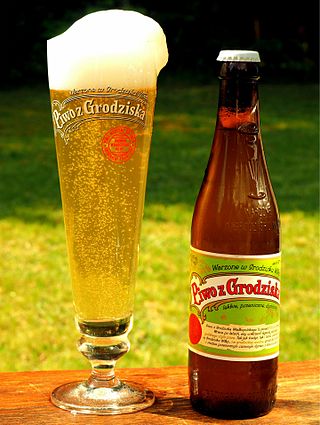
Grodziskie is a historical beer style from Poland made from oak-smoked wheat malt with a clear, light golden color, high carbonation, low alcohol content, low to moderate levels of hop bitterness, and a strong smoke flavor and aroma. The taste is light and crisp, with primary flavors coming from the smoked malt, the high mineral content of the water, and the strain of yeast used to ferment it. It was nicknamed "Polish Champagne" because of its high carbonation levels and valued as a high-quality beer for special occasions.
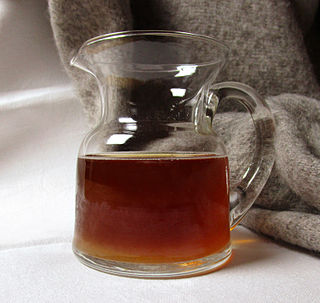
Gotlandsdricka is a traditional homebrewed alcoholic beverage made on the island of Gotland, Sweden. It is a kind of ale, closely related to the Finnish sahti, and Norwegian Maltøl with a smoky, bitter-sweet, spicy (juniper) flavor. It is similar to gruit.
Aerobic fermentation or aerobic glycolysis is a metabolic process by which cells metabolize sugars via fermentation in the presence of oxygen and occurs through the repression of normal respiratory metabolism. It is referred to as the Crabtree effect in yeast. and is part of the Warburg effect in tumor cells. While aerobic fermentation does not produce adenosine triphosphate (ATP) in high yield, it allows proliferating cells to convert nutrients such as glucose and glutamine more efficiently into biomass by avoiding unnecessary catabolic oxidation of such nutrients into carbon dioxide, preserving carbon-carbon bonds and promoting anabolism.
Lachancea thermotolerans is a species of yeast.
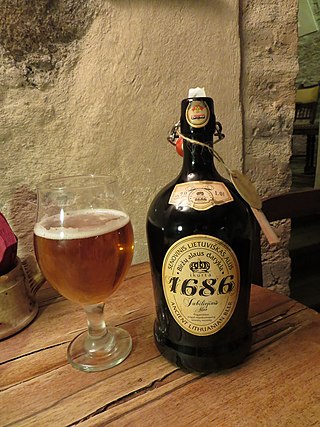
The beer brewing tradition in Lithuania tends to favor the northern part of the country and is centered around the towns of Pasvalys, Pakruojis, Kupiškis and Biržai. The farmhouse brews of the region are highly distinctive, using local ingredients and techniques from past generations. Lithuanian farmhouse beer has a soft, sweetish malty palate, with hops that do not dominate the flavor profile.